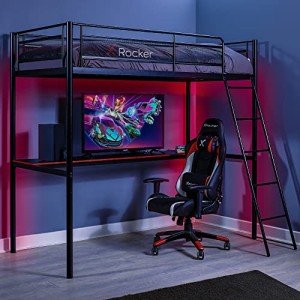The Comprehensive Guide to Bunk Beds House: Maximizing Space and Functionality
Bunk beds are ending up being significantly popular in contemporary families, especially for those living in restricted space. Whether in a kid's bed room, a visitor room, and even a getaway home, bunk beds offer an ingenious option for taking full advantage of space while likewise accommodating several sleepers. This post explores the different aspects of bunk beds, their style options, advantages, and factors to consider for maintenance to assist anyone thinking about a bunk bed purchase make an informed decision.
Understanding Bunk Beds
Bunk beds are a kind of bed that includes one bed stacked on top of another, generally protected by a ladder or built-in stairs. They are often made from wood or metal, with styles varying from standard to contemporary. Bunk beds are most typically used in kids's spaces, guest lodgings, and summertime camps, but they can likewise be a great addition to little apartments or homes.
Types of Bunk Beds
Understanding the ranges of bunk beds can help one pick the right design for one's needs. Here are the typical types:
| Type | Description | Pros | Cons |
|---|---|---|---|
| Requirement Bunk | 2 beds stacked on top of each other | Space-saving, traditional style | Minimal sleeping capacity for adults |
| Loft Bed | A bed elevated with open space beneath for a work area or play location | Offers extra functional space | Not ideal for younger children |
| Futon Bunk | A bed on top, frequently with a futon on the bottom | Versatile for sleeping and seating | Less stability compared to traditional bunks |
| L-Shaped Bunk | 2 beds arranged in an L-shape, often with storage alternatives | Distinct style, can fit in corners | Uses up more space than basic bunk beds |
| Triple Bunk | Three beds arranged vertically or in an unique setup | Maximizes sleeping space | Greater danger of accidents, more complex to make |
Benefits of Bunk Beds
Bunk beds provide various benefits, making them a practical furnishings option for different living spaces. The advantages include:
- Space Efficiency: Perfect for small rooms, they enable more floor space, making it much easier to walk around.
- Double Functionality: Especially when it comes to loft-style beds, the space below can be used for a study area, a play zone, or extra storage.
- Social Interaction: Bunk beds develop a sense of camaraderie amongst brother or sisters or roomies, promoting sharing and bonding.
- Cost-Effective Sleeping Solution: They offer a budget friendly way to accommodate several guests without the requirement to buy additional different beds.
- Style Variety: With options ranging from streamlined modern-day designs to traditional wood structures, there is a bunk bed design to match any design.
Crucial Considerations for Bunk Beds
While bunk beds offer numerous advantages, there are particular factors to consider to keep in mind to ensure security and longevity:
- Weight Capacity: Always check the weight limitation of the bunk bed to avoid accidents. The majority of basic bunk beds have weight capabilities in between 200-400 pounds.
- Material Quality: Opt for resilient materials such as solid wood or state-of-the-art metal to guarantee stability and durability.
- Safety Features: Look for designs with guard rails on the top bunk and wide ladders. Guarantee that the bed feet are steady and secure.
- Age Appropriateness: Young children should not oversleep the leading bunk, as the risk of falling is substantially increased.
- Assembly: Some bunk beds can be intricate to assemble. Ensure that good guidelines are readily available, or think about professional assembly.
Upkeep of Bunk Beds
Proper maintenance of bunk beds is necessary for ensuring their convenience and safety. Here are some ideas for maintenance:
- Regular Inspections: Periodically examine the stability of the bed, making sure all screws and elements are tight and safe and secure.
- Cleaning up: Dust the furniture routinely and clean up any spills immediately to maintain the stability and look of the beds.
- Bed mattress Care: Rotate mattresses periodically to prevent wear and drooping. Consider hypoallergenic bed mattress protectors for included comfort and tidiness.
- Readjust if Moved: If the bed is transferred, readjust all components to make sure continued safety and stability.
Frequently Asked Questions about Bunk Beds
Q1: Are bunk beds safe for children?A1: Yes, as long as safety guidelines are abided by. Make sure the leading bunk has guardrails, which kids are old sufficient and accountable sufficient to securely utilize the leading bunk. Q2: How much weight can a bunk
bed support?A2: Most bunk beds support in between 200 to 400 pounds per bed
, however this can differ by design. Constantly describe the producer's requirements. Bunk Beds Store : Can adults sleep in bunk beds?A3: Yes, lots of modern bunk beds are
developed to accommodate adults, particularly those with enhanced frames. Q4: Do bunk beds need special mattresses?A4: Not always. Requirement mattresses can be utilized as long as they fit the
dimensions provided by the manufacturer. However,
consider utilizing thinner mattresses for the leading bunk to guarantee security clearance. Q5: How can I make the most of space in a room with bunk beds?A5: Use the location beneath for storage or desks, and consider incorporating vertical storage
options to keep the space uncluttered. Bunk beds use an exceptional option for optimizing space in a home while providing a trendy and practical sleeping plan. Whether for a child's space, a guest space, or a vacation house, they are a versatile alternative that can accommodate different requirements. By considering types, advantages, and proper maintenance, individuals can make educated decisions, guaranteeing safety and durability in their bunk bed investment. With cautious selection, bunk beds can enhance both comfort and visual appeal in any room.

